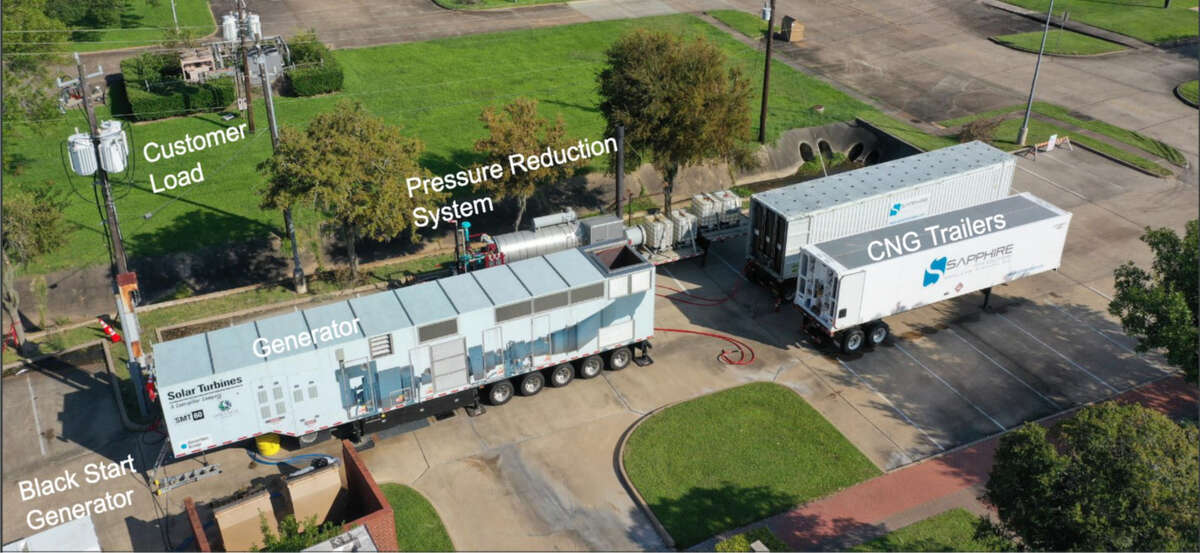
Original Source: PUC: CenterPoint can recover $200 million from Houston customers (houstonchronicle.com)
 CenterPoint used one of Life Cycle Power’s mobile generation units, shown here, to provide power to a community center in Lake Jackson after Hurricane Nicholas. CenterPoint has leased 500 megawatts of mobile generation, which will cost ratepayers about $200 million. Critics argue CenterPoint rushed the contracting process.
CenterPoint used one of Life Cycle Power’s mobile generation units, shown here, to provide power to a community center in Lake Jackson after Hurricane Nicholas. CenterPoint has leased 500 megawatts of mobile generation, which will cost ratepayers about $200 million. Critics argue CenterPoint rushed the contracting process.
Electricity customers in Houston are about to see their bills increase after the state Public Utility Commission gave a green light for CenterPoint to increase its rates.
The increase comes as CenterPoint seeks to recoup $200 million in costs it incurred to to lease mobile generators which could produce 500 megawatts of emergency power during peak periods of demand. It was allowed to seek the rate increase in part because it backed a change in state law after the deadly blackouts in February 2021, and the prospect of the increase has raised hackles among consumer advocates.
Prior to the winter freeze in 2021, regulated transmission and distribution companies like CenterPoint were barred by Texas law from owning any power generation in the state. After the event, CenterPoint was among those that lobbied the legislature to pass a bill allowing transmission and distribution companies to lease and operate emergency power generation equipment. That law went into effect in September 2021.
With the law in place, CenterPoint asked the state’s Public Utility Commission to approve an increase to allow it to recover a number of costs, including those for the mobile generators.
It’s among the first cases in which the PUC has considered emergency generation in a transmission and distribution company’s rate base, the fixed monthly fee passed onto customers, and it gave the verbal OK in an open meeting on March 9. Commissioners are expected to sign the final order in the coming weeks.
Sandra Haverlah, president of the nonprofit advocacy group Texas Consumer Alliance, said every time a utility adds a cost to the rate base, there should be robust public engagement and significant analysis of alternatives, and CenterPoint’s lease of emergency mobile generators didn’t meet those standards.
“This is a very questionable purchase by CenterPoint,” Haverlah said, “And to load it onto the consumers in their territory without a process where people could have feedback about the necessity of the item is pretty bold on the part of CenterPoint – and disappointing that the PUC has agreed to it.”
Under the law, CenterPoint is able to recover the cost of leasing and operating the emergency generation units, as well as 6.5 percent return on every dollar it spends on leasing, operating and maintaining the units.
Jason Ryan, the company’s executive vice president of regulatory services and government affairs, said the company worked with PUC staff to spread out the cost of the mobile generators over time so it would represent less than a $1 dollar increase of the rate base on monthly bills.
But consumer advocates said Texas utilities have been layering on costs gradually that add up to significant increases in bills for customers.
In September, CenterPoint began charging residential ratepayers on average an additional $11.45 per month for transmission and distribution costs. The fixed portion of the bill, which is separate from the per-kilowatt rate chosen through a retail electricity plan, now makes up around 40 percent of a customer’s bill – a 10 percent jump from when the state’s electricity market design went into effect in 2002, according to state data.
Concerns were raised about the CenterPoint deal as soon as the company included it in the cost recovery request to the PUC in April of last year, but mostly through filings from trade groups and others who watch the electricity market closely. Haverlah said there’s a very slim window for the public to make comments, and it’s challenging for consumers to learn how that process even works.
Shortly after receiving the request, the PUC sent the case for review by an administrative hearing judge, who said the mobile generation units should not be included among costs that go into ratepayer bills. But the PUC is not bound to accept the judge’s opinion, and when the case was returned to it in January and discussed at its March meeting, commissioners voted to amend the judge’s order and include the units.
Of the five PUC members, who are appointed by the governor, Commissioner James Glotfelty voted against the order.
“I think it was an easy way to put a couple hundred million dollars in the rate base and get recovery for it,” Glotfelty said. “And I think that’s not in the best interest of consumers in the long run.”
The mobile units are meant to be used in emergencies, when customers are in jeopardy of going days without power because of an intense weather event, CenterPoint’s Ryan said.
Haverlah, with the Texas Consumer Association, said most Texans support increasing electricity reliability in the face of storms, but that CenterPoint rushed to purchase these units instead of engaging customers in the process. Now consumers will be paying for the units for years.
Ryan said he advocated for the law to allow companies like CenterPoint to own emergency mobile generation because it gives utilities another tool to guard against deadly power outages.
The company leased the units immediately after the law was signed, he said. “Nobody would have been impressed if that law had passed and we didn’t have the assets, and a major event happened and we weren’t ready.”
These are just some of the pain points utilities are currently facing. Click on the button below to learn more.



